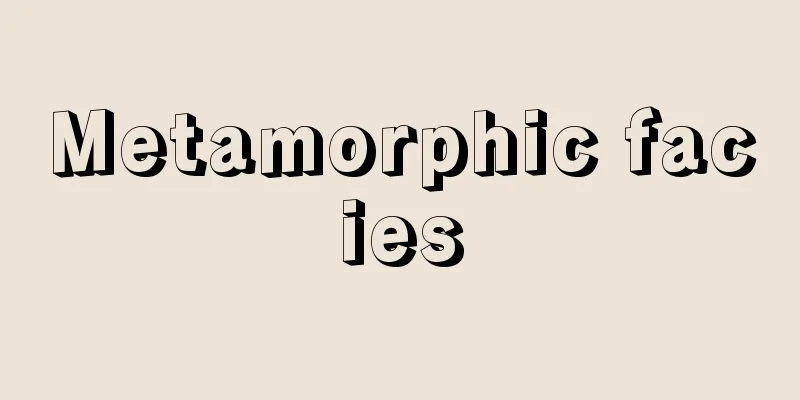Metamorphic facies

|
In 1920, Eskola came up with the concept of mineral facies to compensate for the deficiencies of metamorphic zones. This deals with mineral assemblages given temperature and pressure conditions that were formed in near-equilibrium conditions. He considered mineral assemblages that excluded residual crystals. Based on the mineralogical phase rule, Eskola grouped rocks that were metamorphosed under the same temperature and pressure conditions into one group, which he named metamorphic facies [Eskola: 1915]. What is distinctive about Eskola's concept of mineral facies is that he understands the differences in the conditions under which metamorphic rocks were formed not as a single type of mineral, but as a combination of minerals. The concept of mineral assemblages was described by Goldschmidt as the mineralogical phase rule, but what is significant is that he applied this theory to all actual rock groups [Suzuki: 1994]. Eskola's concept of metamorphic facies can also be applied to igneous rocks, so he called the igneous facies the case of igneous rocks, and called the metamorphic and igneous facies collectively the mineral facies [Eskola: 1920]. The term metamorphic facies has since been developed, but the term igneous facies is no longer used today. Metamorphic facies includes rocks of any chemical composition and origin that have undergone metamorphism under a specific set of physical conditions and have reached chemical equilibrium. In a given facies, the mineral composition of the rock is determined purely by the total chemical composition at the end of the metamorphic process. This principle holds true regardless of whether the rock has been reconstructed by increasing or decreasing temperature, by the mechanism of reactions, or by the presence of metasomatism (Eskola: 1920, 1922, Turner & Verhoogen: 1957). A particular facies is defined as a specific mineral assemblage that is stable only within a narrow range of temperatures and pressures. A phase defined in this way is called a critical rock type or critical mineral assemblage. Rocks belonging to the same facies are called an isograde or isofacial (Tilley: 1924). Source: Asakura Publishing Dictionary of Petrology Information |
|
エスコラは1920年に変成帯の不備を補うため鉱物相(mineral facies)を考えた.これは温度,圧力条件で与えられた鉱物組合せで,ほぼ平衡状態で形成されたものについての取り扱いである.残晶を除いた鉱物組合せを考えた.エスコラは鉱物学的相律から,同一温度,圧力の条件下で変成した岩石をまとめて一つのグループとし,これを変成相と名づけた[Eskola : 1915].エスコラの鉱物相の考え方の特徴は,変成岩の形成条件の違いを一種類の鉱物ではなくて,鉱物の組合せとして理解していることである.鉱物組合せという考え方はゴールドシュミットによって鉱物学的相律として述べられているが,この理論を実際のすべての岩石群に適用したことに重要な意味がある[鈴木 : 1994]. エスコラの変成相の考えは火成岩にも適用されるので,火成岩の場合を火成相とし,変成相と火成相を合わせて鉱物相(mineral facies)とよんだ[Eskola : 1920].その後変成相は発展したが,火成相は現在は用いられていない. 変成相はあらゆる化学組成であらゆる起源の岩石で,特定の物理的条件の組合せの条件で変成作用が行われ化学平衡に到達したものを含んでいる.ある変成相では,岩石の鉱物組成は変成作用が終わった時の全化学組成で純粋に決定される.この原理は,岩石の再構築が,温度上昇か温度下降,反応の機構,交代作用の存在,に応じて行われたかどうかに関係なく成立する[Eskola : 1920, 1922, Turner & Verhoogen : 1957].特定の相は特定の鉱物組合せが,温度および圧力の狭い範囲内でのみ安定であると定義されている.このように定義された相はcritical rock type またはcritical mineral assemblageと呼ぶ.同じ相に属する岩石をアイソグレード(isograde)またはアイソフェイシャル(isofacial)と呼ぶ[Tilley : 1924]. 出典 朝倉書店岩石学辞典について 情報 |
<<: Metamorphic belt - Hensei-tai
>>: Metamorphism - Metamorphism
Recommend
Domestic Relations Tribunal - Domestic Relations Tribunal
...It can be said that these factors are the reas...
Powdery mildew - Powdery mildew
…It occurs on many crops and trees, including bar...
Ginza Haccho - Ginza Haccho
A novella by Takeda Rintaro. A group drama set in ...
Product cycle theory - Product cycle theory
A dynamic international division of labor theory r...
Sending wolf - Sending wolf
...When a wild boar or deer jumps out of the moun...
TRH
thyrotropin-releasing hormone Source : Internal Me...
Rice Marriage - Ine no Kekkon
...It is also said that within the last sheaf are...
Auger effect
When an atom is bombarded with electron or X-rays...
Akashi Park - Akashi Park
(Akashi City, Hyogo Prefecture) A tourist attracti...
Inserted blade milling cutter - Uevafryce
…As shown in Figure 1, depending on the purpose o...
Wootz, JP - Wootz
...Its influence extends widely from Goethe to th...
Donetsk (English spelling) Донецк/Donetsk
The capital of Donetsk Oblast in Ukraine. It was ...
Enkyobo Kensei - Enkyobo Kensei
...The name Tamon-in Diary comes from the fact th...
Cynoglossus interruptus
…[Katsumi Matsushita]. . … *Some of the terminolo...
Morality play - English
A type of drama that was popular from the late Mi...









